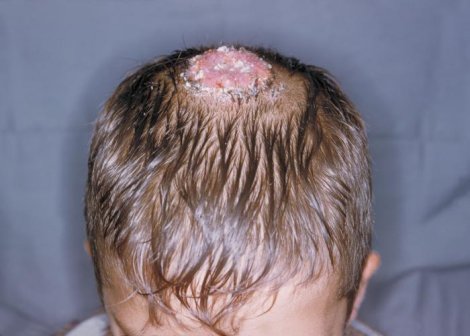Ringworm: Its Symptoms and Treament

Tinea is more known to everybody as a ringworm. It is a fungal infection that affects skin. Tinea Capitis is a scalp ringworm and is considered to be the most common hair loss reason in children throughout the world (50% cases).
Long time ago it was believed that this disease is caused by a worm which gave a name to the infection (tinea is a Latin word for “growing worm”). Although it has been discovered later that it comes from fungi, the name of the infection was already so common that it remained unchanged.
Dermatophytes, the ringworm fungi, are found in humans and animals, especially house pets like cats and dogs. They also live in the skin of farm animals and in soil. The infection is very contagious and is usually spread from person to person through objects like towels, hair brushes, scissors and other barbershop instruments, clothes, theatre or car seats, etc. As a rule, a simple contact with one of these objects might not result in infection, however, together with minor scratches or tight braiding dermatophytes get through the top layer of skin and start growing causing various kinds of discomfort.
All types of ringworm infection cause reddening, intense itching, crusting and scaling of the scalp. However, there are other symptoms which vary due to different origin of the fungi.
• Black dot ringworm is the most common infection nowadays in the U.S. The reason to it is Trichophyton, which mostly affects hair shaft. In this case the hair becomes brittle and breaks at the scalp resulting in bald patches. The disease received its name because the parts of the hair that are left in the follicle look like it has been shaved off a few days before, appearing like “black dots”.
• Gray patch ringworm is also wide spread. It was dominant in 1940’s and 1950’s in the United States. These days it is less common is America, but is a primary ringworm infection in Eastern Europe. Microsporum is the fungus that brings this infection, the main first symptoms of which are intense itching and red bumps around hair shafts. The infected patches slowly increase in size, resulting in red scaly “rings”. The hair in the patches becomes gray and dull, eventually breaking off.
• Inflammatory ringworm is another variety of the infection. It is caused by different fungi which come from animals or soil. Although it is the least common one, it hurts the most. The symptoms of this kind of infection are fever, pain, itchiness and enlarged lymph nodes. The infected areas look like they have small pustules, abscesses or kerion formations (elevated soft places which ooze pus). If not treated in time, inflammatory ringworm might result in permanent hair loss and scars.
Sometimes the infection can go away without any specific treatment; however, doctor consultation is required especially if a child has intensive scalp itching, scaling or starts losing hair. As a rule, specialists prescribe oral antifungal medications together with special shampoos. Primary drug for ringworm is Griseofulvin (Fulvicin, Grisactin), but if it does not bring effect or the patient is allergic to it, some alternatives might be used. Prednisone helps to relieve the symptoms of the inflammatory ringworm and is prescribed along with Griseofulvin.
In order to decrease hair shedding and itching, it is recommended to use shampoos with selenium sulfide (2.5%) or zinc pyrithione (1-2%) two or three times weekly. Such shampoos are Head & Shoulders Intensive Treatment, Selsun, Selsun Blue and Selsun Gold for Women.
John Meyer
Posted on May 15, 2009
Filed Under Hair Loss, Hair Loss Diagnosis, Hair Loss Reasons, Hair Loss Treatments
Comments
Leave a Reply
